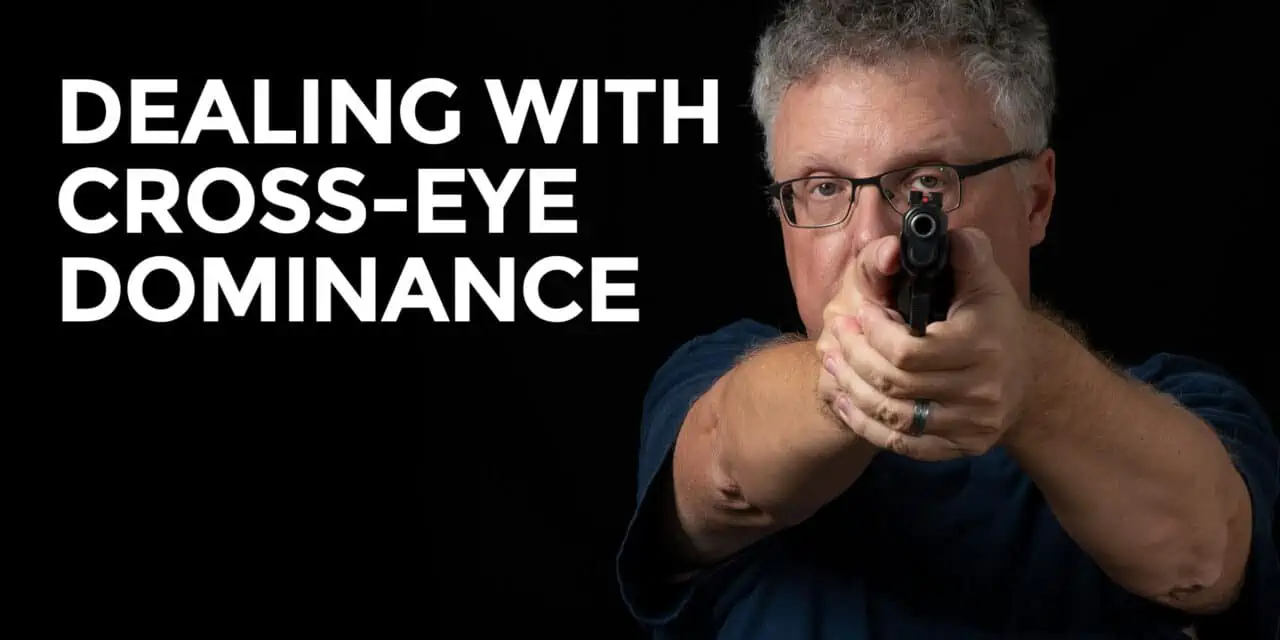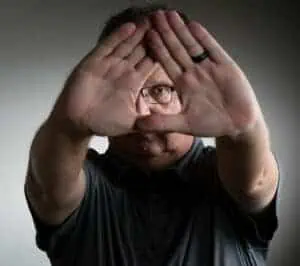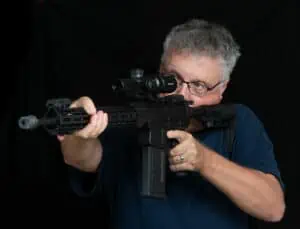Learning How To Shoot With Cross Eye Dominance
Growing up, I could never figure out why I performed some sporting activities with my right hand, and some with my left. I played hockey and baseball right-handed, yet I shot a bow left-handed. It wasn’t until I took my first firearms training course that I figured out why this was so. I am right-handed, but my dominant eye is my left eye. I was (and am) cross eye dominant.
Humans have binocular vision, which means that both our eyes point forward. This is a trait we share with most other predatory mammals. It allows us great depth perception and an increased ability to track our prey. However, our brain prioritizes the signals from one of our eyes over the other, and that means that one of our eyes is dominant over the other one.
Cross eye dominance is when your dominant eye is different than your dominant hand. In my case, I am right-handed, but my left eye is my dominant eye. Eighteen percent of people are cross eye dominant, while seventeen percent have no dominant eye. The other sixty-five percent have a dominant eye that matches their dominant hand. While I am right-handed and left eye dominant, you can also have cross eye dominance if you’re left-handed. In that case, your right eye would be your dominant eye.
What Is Cross Eye Dominance
Eye dominance is not a problem for most people. They never are put in a position where they need to figure out their dominant eye, or they are in the majority of people whose dominant eye matches their dominant hand. The rest of us, though, need to find ways to deal with the fact that our brain wants input from the side of our body that is different from how we perform most everyday tasks.
There are a couple of easy tests to find your dominant eye. The first is to fix your gaze on an object that’s five yards or more off in the distance, and then frame that object with your outstretched hands. Slowly pull your hands back to your face, with your vision still fixed on that distant object. Your hands will wind up in front of one of your eyes, and that is your dominant eye.
The second test is even easier. With both eyes open, point at a distant object. Keep pointing at that object, then close one eye. If your finger is still in-line with the object you pointed to, that is your dominant eye. If your finger is shifted away from the object, your other eye is your dominant eye.
Adapting To Cross Eye Dominance
There are three different ways to deal with cross eye dominance when shooting a gun. The first is to adapt your eyes, the second is learn to shoot with your non-dominant hand and the last is adapting your shooting style and guns to work with how you see. We’ll look at both of these in-turn to figure out which might be best for you if you have cross-eye dominance.
One technique for dealing with cross eye dominance is to adapt your vision to match your dominant hand. People who choose this technique will put some form of vision block over their dominant eye and then shoot using their other eye. Common vision blocks for this technique are small pieces of cellophane tape on the shooter’s protective eyewear that blurs out what they’re seeing with their dominant eye, or a small purpose-built vision block that blocks out what the dominant eye sees.
Shooting with your other hand is an effective way to deal with cross eye dominance if you’re naturally left-handed. Most guns are set up for right-handed use right out of the box, which opens up many more options for the left-handed shooter. In addition to this, learning to shoot well with your off hand is a good idea for all gun owners, making this an effective training tool as well as a way to adapt to a difference in dominant eye and dominant hand.
Taking It To The Range
Altering your shooting style to how your brain sees the world takes some time and some practice. However, unlike altering your shooting glasses or vision blocks, it can be used in a real world defensive encounter as well as at the shooting range. When shooting a pistol, I shift my stance slightly so the sights of my pistol align with my left eye. When I shoot long guns like a rifle or a shotgun, I change to the second option, shooting them left-handed and lining up their sights with my dominant left eye.
That sounds easy in theory, but what it means in the real word is that I have to either choose my guns so they work well with the left hand, or adapt them for use with that hand. For instance, my AR-pattern guns have ambidextrous safeties on them, which is a relatively easy modification for that type of gun. When it comes to shotguns, I either shoot a gun that has a safety on the stock, such as the Mossberg 500, or I reverse the safety to allow it to be easily used with my left hand.
Shooting a bolt action rifle can be a challenge if you need to use it left-handed. There are many manufacturers who make left-handed bolt action rifles. Savage in particular has an extensive line of left-handed rifles that are quite good and quite inexpensive, making them my “go to” option for anything that is meant for long-range work.
Work With Your Vision, Not Against It
Dealing with cross eye dominance does require extra effort, but it’s not hard. With a little practice and some help from a knowledgeable trainer, you can adjust your shooting technique to match how your mind and body work, and move on to other rewarding and enjoyable aspects of the shooting sports.





Thanks for the article. Like you I do some things right handed like golf and baseball. I’m left handed and right eyed. Learning to shoot with the right hand is probably not an option for me. Too much retraining. Of course if you shoot with one eye closed dominance is not an issue. Although as having been in shooting situations during my military service and police career one tends to keep both eyes open during high stress incidents. I don’t think the Army ever knew about cross dominance and it wasn’t part of training (except for a short course of experiential training in point shooting shooting quarter size slugs out of the air with BB guns. I have no idea where that type of training went) so even though I qualified as Expert I can only guess that I naturally adjusted my aim. Of course with left handedness the weapons controls have to be learned but we are used to the right handed world. In fact I prefer right handed controls on my pistols as I am used to using them. Although lack of ambidextrous safeties generally lead me away from 1911’s for carry. What I have been trying to do is bring the pistol slightly over to the right eye or canting the pistol slightly clockwise for my right eye to dominate the sight.